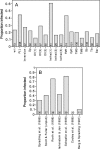Widespread prevalence of wolbachia in laboratory stocks and the implications for Drosophila research
- PMID: 15937134
- PMCID: PMC1449785
- DOI: 10.1534/genetics.104.038901
Widespread prevalence of wolbachia in laboratory stocks and the implications for Drosophila research
Abstract
Wolbachia is an intracellular microbe harbored by a wide variety of arthropods (including Drosophila) and filarial nematodes. Employing several different strategies including male killing, induced parthenogenesis, cytoplasmic incompatibility, and feminization, and acting by as-yet-unknown mechanisms, Wolbachia alters host reproduction to increase its representation within a population. Wolbachia is closely associated with gametic incompatibility but also interacts with Drosophila in other, little understood ways. We report here significant and widespread infection of Wolbachia within laboratory stocks and its real and potential impact on Drosophila research. We describe the results of a survey indicating that approximately 30% of stocks currently housed at the Bloomington Drosophila Stock Center are infected with Wolbachia. Cells of both reproductive tissues and numerous somatic organs harbor Wolbachia and display considerable variation in infection levels within and between both tissue types. These results are discussed from the perspective of Wolbachia's potential confounding effects on both host fitness and phenotypic analyses. In addition to this cautionary message, the infection status of stock centers may provide further opportunities to study the genetic basis of host/symbiosis.
Figures




Similar articles
-
Overcoming cytoplasmic incompatibility in Drosophila.Proc Biol Sci. 1998 Mar 7;265(1394):391-5. doi: 10.1098/rspb.1998.0307. Proc Biol Sci. 1998. PMID: 9523438 Free PMC article.
-
Wolbachia-induced cytoplasmic incompatibility is associated with decreased Hira expression in male Drosophila.PLoS One. 2011 Apr 29;6(4):e19512. doi: 10.1371/journal.pone.0019512. PLoS One. 2011. PMID: 21559343 Free PMC article.
-
Wolbachia infections in Drosophila melanogaster and D. simulans: polymorphism and levels of cytoplasmic incompatibility.Genetica. 2004 Mar;120(1-3):51-9. doi: 10.1023/b:gene.0000017629.31383.8f. Genetica. 2004. PMID: 15088646 Review.
-
Genome-wide analysis of the interaction between the endosymbiotic bacterium Wolbachia and its Drosophila host.BMC Genomics. 2008 Jan 2;9:1. doi: 10.1186/1471-2164-9-1. BMC Genomics. 2008. PMID: 18171476 Free PMC article.
-
Living in the endosymbiotic world of Wolbachia: A centennial review.Cell Host Microbe. 2021 Jun 9;29(6):879-893. doi: 10.1016/j.chom.2021.03.006. Epub 2021 May 3. Cell Host Microbe. 2021. PMID: 33945798 Free PMC article. Review.
Cited by
-
The endosymbiont Wolbachia increases insulin/IGF-like signalling in Drosophila.Proc Biol Sci. 2009 Nov 7;276(1674):3799-807. doi: 10.1098/rspb.2009.0778. Epub 2009 Aug 19. Proc Biol Sci. 2009. PMID: 19692410 Free PMC article.
-
The bacterial symbiont Wolbachia induces resistance to RNA viral infections in Drosophila melanogaster.PLoS Biol. 2008 Dec 23;6(12):e2. doi: 10.1371/journal.pbio.1000002. PLoS Biol. 2008. PMID: 19222304 Free PMC article.
-
Meta-analysis suggests the microbiome responds to Evolve and Resequence experiments in Drosophila melanogaster.BMC Microbiol. 2021 Apr 9;21(1):108. doi: 10.1186/s12866-021-02168-4. BMC Microbiol. 2021. PMID: 33836662 Free PMC article.
-
The rich somatic life of Wolbachia.Microbiologyopen. 2016 Dec;5(6):923-936. doi: 10.1002/mbo3.390. Epub 2016 Jul 26. Microbiologyopen. 2016. PMID: 27461737 Free PMC article. Review.
-
Quantitative methods for assessing local and bodywide contributions to Wolbachia titer in maternal germline cells of Drosophila.BMC Microbiol. 2019 Sep 3;19(1):206. doi: 10.1186/s12866-019-1579-3. BMC Microbiol. 2019. PMID: 31481018 Free PMC article.
References
-
- Bandi, C., M. Sironi, C. A. Nalepa, S. Corona and L. Sacchi, 1997. Phylogenetically distant intracellular symbionts in termites. Parassitologia 39: 71–75. - PubMed
-
- Bandi, C., J. W. McCall, C. Genchi, S. Corona, L. Venco et al., 1999. Effects of tetracycline on the filarial worms Brugia pahangi and Dirofilaria immitis and their bacterial endosymbionts Wolbachia. Int. J. Parasitol. 29: 357–364. - PubMed
-
- Bohni, R., J. Riesgo-Escovar, S. Oldham, W. Brogiolo, H. Stocker et al., 1999. Autonomous control of cell and organ size by CHICO, a Drosophila homolog of vertebrate IRS1–4. Cell 97: 865–875. - PubMed
MeSH terms
LinkOut - more resources
Full Text Sources
Molecular Biology Databases

